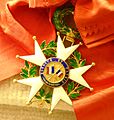
Legion of Honour
The National Order of the Legion of Honour (French: Ordre national de la Légion d'honneur [ɔʁdʁ nɑsjɔnal də la leʒjɔ̃ dɔnœʁ]), formerly the Royal Order of the Legion of Honour (Ordre royal de la Légion d'honneur), is the highest French order of merit, both military and civil, and currently comprises five classes. Established in 1802 by Napoleon Bonaparte, it has been retained (with occasional slight alterations) by all later French governments and regimes.
"Legion of Honor" redirects here. For other uses, see Legion of Honor (disambiguation).
National Order of the Legion of Honour
Ordre national de la Légion d'honneur
19 May 1802
Honneur et patrie ("Honour and Fatherland")
Military and civilians
delivered, upon official investigation
Julien Le Gars
- 1 Grand-maître
- 67 Grand(s)-croix
- 314 Grand(s) officier(s)
- 3,009 Commandeur(s)
- 17,032 Officier(s)
- 74,384 Chevalier(s)
15 July 1804
None
- Order of Liberation
(ceased 24 January 1946)[1]
The order's motto is Honneur et Patrie ("Honour and Fatherland"); its seat is the Palais de la Légion d'Honneur next to the Musée d'Orsay, on the left bank of the Seine in Paris.[a] Since 1 February 2023, the Order's grand chancellor has been retired General François Lecointre, who succeeded fellow retired General Benoît Puga in office.
The order is divided into five degrees of increasing distinction: Chevalier (Knight), Officier (Officer), Commandeur (Commander), Grand officier (Grand Officer) and Grand-croix (Grand Cross).
The order has had five levels since the reign of King Louis XVIII, who restored the order in 1815. Since the reform, the following distinctions have existed:
Due to the order's long history, and the remarkable fact that it has been retained by all subsequent governments and regimes since the First Empire, the order's design has undergone many changes. Although the basic shape and structure of the insignia has remained generally the same, the hanging device changed back and forth and France itself swung back and forth between republic and monarchy. The central disc in the centre has also changed to reflect the political system and leadership of France at the time. As each new regime came along the design was altered to become politically correct for the time, sometimes even changed multiple times during one historical era.
The badge of the Légion is shaped as a five-armed "Maltese Asterisk", using five distinctive "arrowhead" shaped arms inspired by the Maltese Cross. The badge is rendered in gilt (in silver for chevalier) enameled white, with an enameled laurel and oak wreath between the arms. The obverse central disc is in gilt, featuring the head of Marianne, surrounded by the legend République Française on a blue enamel ring. The reverse central disc is also in gilt, with a set of crossed tricolores, surrounded by the Légion's motto Honneur et Patrie (Honour and Country) and its foundation date on a blue enamel ring. The badge is suspended by an enameled laurel and oak wreath.
The star (or plaque) is worn by the Grand Cross (in gilt on the left chest) and the Grand Officer (in silver on the right chest) respectively; it is similar to the badge, but without enamel, and with the wreath replaced by a cluster of rays in between each arm. The central disc features the head of Marianne, surrounded by the legend République Française (French Republic) and the motto Honneur et Patrie.[27]
The ribbon for the medal is plain red.
The badge or star is not usually worn, except at the time of the decoration ceremony or on a dress uniform or formal wear. Instead, one normally wears the ribbon or rosette on their suit.
For less formal occasions, recipients wear a simple stripe of thread sewn onto the lapel (red for chevaliers and officiers, silver for commandeurs). Except when wearing a dark suit with a lapel, women instead typically wear a small lapel pin called a barrette. Recipients purchase the special thread and barrettes at a store in Paris near the Palais Royal.[28]
























